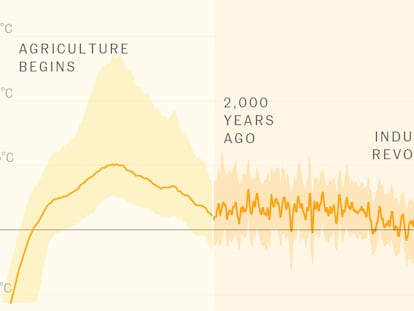Eight months of consecutive heat records: January 2024 was the warmest ever on Earth
This January and 2023 as a whole are not an exception, they are part of a trend: the last nine years (2015-2023) were the hottest ever recorded

We can look the other way and avoid acting against climate change and its main causes — fossil fuels — but this crisis will continue to worsen and set new records. 2023 was the hottest year on Earth since records began in the mid-19th century (although paleoclimate scientists argue that you have to go back several millennia to find such warming on the planet). Last month was another case in point: it was the warmest January ever recorded. There have now been eight consecutive record-breaking months, according to information released Thursday by the European Union’s Copernicus Climate Change Service.
This data takes into account the average temperatures on the planetary surface. But if the focus narrows more the panorama does not change much: in Spain as a whole, for example, January was the warmest month in the historical records of the State Meteorological Agency, which in this case began in 1961. “It was an extremely warm month,” the Ministry for Ecological Transition and Demographic Challenge said Wednesday
To find the causes behind such warm temperatures, we must look directly toward climate change. Without global warming — caused by greenhouse gases expelled by the global economy and accumulating in the atmosphere — these sustained records over time would be virtually impossible. January and 2023 as a whole are not an exception, they are part of a trend: the last nine years (2015-2023) were the warmest ever recorded. And science has established a direct link between this warming and greenhouse gases. Chief among them is carbon dioxide (CO₂), the concentration of which in the atmosphere has been growing steadily since the Industrial Revolution. Scientists explain that it is necessary to go back between 800,000 and two million years to find a similar accumulation of CO₂.
But this human-generated background warming is compounded by other factors linked to planetary climate variability, as seems to be happening with the El Niño phenomenon. In June last year, this natural pattern began, causing water surface temperatures in tropical areas of the Pacific to rise, which ultimately influences the global climate. Copernicus now indicates that El Niño has begun to weaken in the equatorial Pacific, although “sea air temperatures in general remained at an unusually high level.” In fact, these are also at record levels. According to Copernicus data, during late January and the early February this year, historical records for sea temperature in the extra-polar global ocean have been exceeded.
“2024 starts with another record-breaking month — not only is it the warmest January on record but we have also just experienced a 12-month period of more than 1.5°C above the pre-industrial reference period,” said Samantha Burgess, deputy director of the Copernicus Climate Change Service, in a statement. “Rapid reductions in greenhouse gas emissions are the only way to stop global temperatures increasing.”
The Paris Agreement, which was signed in 2015 and governs global efforts against climate change, sets an overall target that the global temperature increase compared to the pre-industrial average (1850-1900) should remain between 1.5ºC and 2ºC. The global average temperature over the last 12 months (February 2023 to January 2024) stood at 1.52ºC above the pre-industrial average. This does not mean that the most ambitious goal of the Paris Agreement has already failed: for that to happen, the 1.5ºC (2.7ºF) barrier would have to be exceeded steadily (during a decade on average), something that is however expected to happen from the next decade onward.
Sign up for our weekly newsletter to get more English-language news coverage from EL PAÍS USA Edition
Tu suscripción se está usando en otro dispositivo
¿Quieres añadir otro usuario a tu suscripción?
Si continúas leyendo en este dispositivo, no se podrá leer en el otro.
FlechaTu suscripción se está usando en otro dispositivo y solo puedes acceder a EL PAÍS desde un dispositivo a la vez.
Si quieres compartir tu cuenta, cambia tu suscripción a la modalidad Premium, así podrás añadir otro usuario. Cada uno accederá con su propia cuenta de email, lo que os permitirá personalizar vuestra experiencia en EL PAÍS.
En el caso de no saber quién está usando tu cuenta, te recomendamos cambiar tu contraseña aquí.
Si decides continuar compartiendo tu cuenta, este mensaje se mostrará en tu dispositivo y en el de la otra persona que está usando tu cuenta de forma indefinida, afectando a tu experiencia de lectura. Puedes consultar aquí los términos y condiciones de la suscripción digital.









































